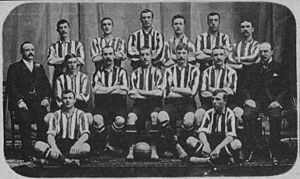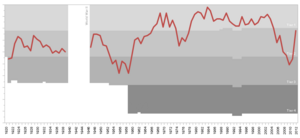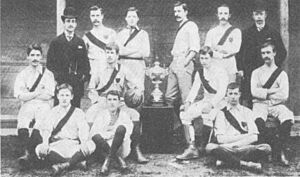History of Southampton F.C. facts for kids
Southampton Football Club is a professional football team from Southampton, England. The club was started in 1885 by members of the St. Mary's Church Young Men's Association. They played their games at different places in Southampton for 13 years. Then, in 1898, they moved to their famous home ground, The Dell, where they stayed until 2001.
Contents
How the Club Started
In 2001, Southampton Football Club moved from The Dell to their new home, St. Mary's Stadium. This move felt like coming home because the new stadium is very close to St. Mary's Church. This is the church where the club was first founded by young men from the St Mary's Church of England Young Men's Association.
The club's very first match was played on November 21, 1885. They played on a field in Northlands Road and won 5–1 against Freemantle. Charles Bromley scored three goals, and A. A. Fry scored two. The goalkeeper, Ralph Ruffell, stayed with the club for almost ten years.
In the beginning, the local newspapers often called the club St. Mary's Y.M.A.. They usually played their early games on Southampton Common. Sometimes, people walking by would interrupt the games! More important matches, like cup games, were played at bigger grounds like the County Ground or the Antelope Cricket Ground.
Changing the Club's Name
The club was first known as St. Mary's Young Men's Association F.C.. Then, in 1887–88, they simply became St. Mary's F.C.. When they joined the Southern League in 1894, they changed their name to Southampton St. Mary's. After winning the Southern League title in 1896–97, the club became a business and finally changed its name to Southampton F.C..

Southampton won the Southern League championship three years in a row, from 1897 to 1899. They won it again in 1901, 1903, and 1904. During this successful time, the club made a big change. In 1898, they moved to a new stadium called The Dell, which cost £10,000 to build. They would play there for the next 103 years!
The club quickly showed promise. Before the 1900s, they reached their first of four FA Cup Finals in 1900. They lost 4–0 to Bury. Two years later, they lost again in the 1902 final to Sheffield United after a replay. Even though they lost, these big games made the club want to achieve more.
In 1904, Southampton F.C. became the first British club to tour South America. They played friendly matches in Argentina and Uruguay. Other English and Scottish clubs followed, helping football grow in South America in the early 1900s.
Joining the Football League
After World War I, many football teams faced challenges. In 1920, Southampton joined the new Football League Division 3. This league split into Southern and Northern sections a year later. The 1920–21 season was a success for Saints, as they won promotion. This started a 31-year period in Division 2.
In 1925 and 1927, Saints reached the semi-finals of the FA Cup. They lost to Sheffield United and Arsenal in those games.
During World War II, a bomb hit The Dell pitch in November 1940. It left a large hole and flooded the field. Because of this, Saints had to play their home matches at Fratton Park, the ground of their local rivals, Portsmouth.
After the War
Southampton almost won promotion in 1947–48 and 1948–49, finishing third both times. In 1949–50, they missed promotion by a tiny difference in goal average. Charlie Wayman scored 56 goals in those two seasons. However, in 1953, the club was relegated back to Division 3 (South).
It took until 1960 for Saints to get back into Division 2. Derek Reeves scored 39 of the team's 106 league goals that season. On April 27, 1963, a huge crowd of 68,000 people watched Saints lose 1–0 to Manchester United in the FA Cup semi-final at Villa Park.
Reaching the Top Division
The dream of playing in Division 1 at The Dell finally came true in 1966. Ted Bates' team was promoted as runners-up. Martin Chivers scored 30 of Saints' 85 league goals that season. This promotion was a truly unforgettable achievement for the club.
For the next season, Ron Davies joined the team and scored 43 goals in his first year. Saints stayed in the top league for eight years. Their best finishes were seventh place in 1968–69 and again in 1970–71. These high finishes allowed them to play in European competitions. They played in the Inter-Cities Fairs Cup in 1969–70 and the UEFA Cup in 1971–72.
In December 1973, long-time manager Ted Bates stepped down. Lawrie McMenemy took over, but he couldn't stop Saints from being relegated in 1974. They were one of the first teams to be relegated under the new system where three teams went down.
FA Cup Glory in 1976
Under Lawrie McMenemy's leadership, Saints began to rebuild in Division 2. They brought in great players like Peter Osgood and Jim McCalliog. The club's greatest moment came in 1976 when they reached the 1976 FA Cup Final. They played Manchester United at Wembley Stadium. Everyone was surprised when Saints beat United 1–0, thanks to a goal from Bobby Stokes!
The next season, Saints played in Europe again in the 1976–77 European Cup Winners' Cup. They reached the third round but lost to the Belgian club Anderlecht.
Back to the Top League
In 1977–78, with Alan Ball as captain, Saints finished second in the Second Division. This meant they were back in the First Division, the top league in English football.
The team finished comfortably in 14th place in their first season back. The next season, they returned to Wembley for the final of the League Cup. They played well but lost 3–2 to Nottingham Forest.
In 1980, McMenemy made a fantastic signing: Kevin Keegan, who was the European Footballer of the Year. Keegan played for Southampton for two years. During this time, Saints had an exciting team with players like Alan Ball, Phil Boyer, and Mick Channon. In 1980–81, the club scored 76 goals and finished in sixth place, which was their highest league finish at the time.
The 1981–82 season was also very good for Saints. By December 1981, they looked like they could win the league title. They even went to the top of the table on January 30, 1982. They stayed at the top for almost two months! However, their form dropped towards the end of the season, and they finished seventh.
Southampton continued to do well under McMenemy. With players like Peter Shilton and Steve Moran, they reached their highest-ever league finish as runners-up in 1983–84. They finished just three points behind champions Liverpool. They also reached the semi-final of the FA Cup, losing to Everton. This meant they came very close to winning both the league and the FA Cup that season.
They finished fifth the next year. However, due to the Heysel Disaster, all English clubs were banned from playing in European competitions. If not for this, Southampton would have qualified for the UEFA Cup again. McMenemy left as manager on June 1, 1985, after almost 12 years. Former player Chris Nicholl took his place.
After McMenemy's Era
Chris Nicholl managed the club for six years and kept them in the top league. He was then replaced by Ian Branfoot in 1991.
A very important player for Southampton during this time was Matthew Le Tissier. He was a striker from Guernsey and was loved by Saints fans. He was voted PFA Young Player of the Year in 1990. He played seven times for the England national team. Le Tissier retired in 2002 at age 33. Bigger clubs, like Manchester United, tried to sign him, but he chose to stay with Saints. He never won a major trophy or played in European football with them, but he was very loyal.
From 1989 to 1992, Le Tissier often played alongside another famous player, Alan Shearer. Shearer scored three goals in his first game for Saints against Arsenal when he was just 17. By 1991–92, he was one of the best strikers in England. In July 1992, Shearer was sold to Blackburn Rovers for a record £3.6 million. He went on to have an amazing career, winning a league title with Blackburn in 1995. He also became the world's most expensive footballer when he moved to Newcastle United for £15 million in 1996. Shearer played 63 times for England, scoring 30 goals.
In the Premier League
Southampton was one of the founding members of the Premiership in 1992–93. They had been in the top division of English football since 1978. However, in May 2005, they were relegated to the second tier of English football for the first time in 27 years.
Ian Branfoot was sacked in January 1994 because Southampton was struggling. Alan Ball became the new manager. Ball helped Saints avoid relegation in 1993–94. He then guided them to a good tenth-place finish in the Premiership in 1994–95, with great performances from Matthew Le Tissier. But Ball left for Manchester City in 1995.
David Merrington, a long-serving coach, took charge for the 1995–96 season. Southampton finished 17th, just avoiding relegation. Two important wins helped them stay up: a 3–1 home win against Manchester United and a 1–0 away win against Bolton Wanderers. Merrington was replaced by Graeme Souness.
Southampton didn't do much better in 1996–97 under Souness. He resigned after one season, and the club hired Dave Jones. Many thought Southampton would be relegated in 1997–98 with an inexperienced manager. But with new players like Kevin Davies, they finished a respectable 12th. Their form dropped in 1998–99, but they avoided relegation on the last day. In 1999, Southampton got permission to build a new 32,000-seat stadium, which was great news after playing in the small Dell since 1898.
During the 1999–2000 season, Dave Jones left his role as manager. He was replaced by former England manager Glenn Hoddle.
Glenn Hoddle helped Southampton stay safely in the Premier League. But he left for Tottenham Hotspur before the end of the 2000–01 season. First-team coach Stuart Gray took over. He oversaw the move to the St Mary's Stadium for the 2001–02 season. In the last ever game at The Dell, Matthew Le Tissier scored the final goal, giving Southampton a 3–2 win against Arsenal. This was a perfect ending to their time at The Dell. But Gray was sacked after a bad start to the next season. Gordon Strachan, former Coventry City manager, became his replacement.
Strachan helped Southampton a lot during the 2001–02 season. They finished in a secure 11th place. The club did even better in its 2002–03 season, finishing eighth in the Premier League. They also reached the FA Cup final, losing 1–0 to Arsenal.
Strachan resigned in March 2004. Paul Sturrock took over, but he was replaced just five months later by Steve Wigley. Wigley's time was difficult, and Southampton kept slipping down the league table. After only one win in 14 games, both Wigley and his assistant were let go.
Chairman Rupert Lowe then appointed Harry Redknapp as manager on December 8, 2004. This was a big surprise because Redknapp had just left his job as manager of Southampton's rivals, Portsmouth.
Relegated After 27 Years
Harry Redknapp couldn't save Saints from relegation. On May 15, 2005, Southampton was relegated from the Premier League after losing 2–1 at home to Manchester United. This ended 27 years of playing in the top division. The season was disappointing, though young star Theo Walcott gave fans some hope.
On November 24, 2005, Portsmouth manager Alain Perrin was sacked. Rumours started that Harry Redknapp would rejoin Portsmouth. Redknapp then left Southampton on December 3, 2005. After some disagreements between the clubs, Redknapp rejoined Portsmouth on December 7, 2005. After three matches with temporary managers, George Burley became the new head coach on December 22.
Changes in Leadership
Due to many calls for him to step down, chairman Rupert Lowe resigned on June 30, 2006. He was replaced by businessman Michael Wilde.
During the 2006–07 season, the club's board tried to find new investors. On February 26, 2007, it was announced that Wilde would step down as chairman. Leon Crouch became the "acting Chairman" until the end of the season.
On April 27, 2007, there were rumours that Paul Allen, who co-founded Microsoft with Bill Gates, might try to buy the club. A source said he believed there was value in UK football and that Southampton was a "sleeping giant."
In the Championship (2005–2009)
Problems off the field affected Southampton's performance during 2005–06. At one point, they were in danger of being relegated again. But their form improved, and they finished a safe 12th.
Their good form continued into the 2006–07 season. By the start of the new year, the team was in fourth place. The new board spent a club record £6 million on new players, including Polish strikers Grzegorz Rasiak and Marek Saganowski, and young left back Gareth Bale. However, the team's form dropped, and they fell to eighth place by mid-March 2007. Despite this, they managed to finish sixth, which was the last play-off spot. They lost their play-off semi-final to Derby County after a thrilling penalty shootout.
The 2007–08 season started normally, but the team's form dropped again in the spring. There were also changes in managers, with George Burley resigning and Nigel Pearson taking over temporarily. Southampton was in serious danger of relegation on the last day of the season. Luckily, they won their game, and other results went their way, keeping them in the Championship.
However, many star players had to be sold. With more changes in managers, the 2008–09 season was very difficult. The club was almost always in the bottom five and never left the relegation zone after Christmas.
In League One (2009–2011)
On April 23, 2009, Southampton was told they would have ten points deducted. This was because their parent company had gone into administration (a type of financial trouble). The points were deducted at the start of the 2009–10 season, which meant Southampton started playing in League One. This was the first time since 1960 that the club was in the third tier of English football.
On July 8, 2009, Swiss businessman Markus Liebherr bought Southampton, saving the club. Alan Pardew became the new manager. On March 28, 2010, Southampton beat Carlisle United 4–1 at Wembley to win the Football League Trophy. Despite this win, the points deduction and a slow start to the season meant they finished seventh. When Markus Liebherr sadly passed away in August 2010, his daughter Katharina Liebherr took over the club.
The next season started well, but Pardew was sacked after a disagreement with the board. Nigel Adkins became the new manager. Under his leadership, the club won promotion as runners-up on the final day of the season, beating Walsall 3–1. This ended their two-year stay in the third division.
Back in the Championship (2011–2012)
Southampton played in the Football League Championship. They showed great determination and by the end of the season, after winning 4–0 against Coventry City, the Saints were back in the Premier League!



